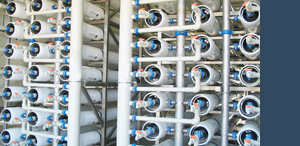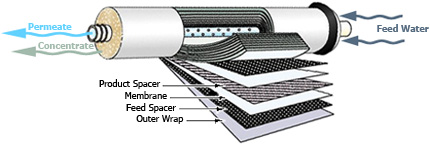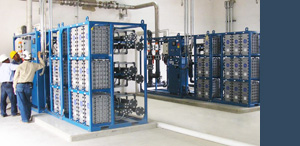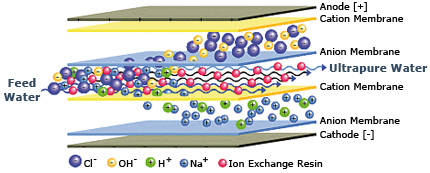Power Plastics
Membrane Filtration Systems - Reverse Osmosis - Electrodeionization
|
Membrane Filtration Systems |
 Membrane systems serve for treatment of sea water, brackish water, drinking and distilled water.
Membrane systems serve for treatment of sea water, brackish water, drinking and distilled water.
Applications: in the petrochemical industry [waste water disposal, back use of technological water], pharmaceutical industry [infusion solutions, production of medicines] and food processing industry [water for production of drinks, processing of fruit and vegetable juices, milk processing] and also during water treatment in water management plants, power stations and thermal plants [demineralised cooling water, additional water for feeding of boilers].
All the membrane systems include high-pressure membranes, high-pressure pumps, an embedded regulator and necessary pre-treatment.
Membrane filtration is a physical process at which a semi-permeable membrane is used for separation and removal of soluble substances, organic colloid substances, viruses and bacteria from water.

|
At present there are used four types of membrane filtrations according to the size of the impurities to be removed:
|
|
Water Treatment & Filtration Technologies |
||||||||
|
Micron Size |
0.0001 |
0.001 |
0.01 |
0.1 |
1.0 |
10 |
100 |
1000 |
|
Examples
Filtration Technology |
Metal Ions |
Aqueous Salts |
Colloids Viruses |
Bacteria |
Pollens Beach Sand |
|||
|
Particle Filtration |
||||||||
|
Microfiltration |
||||||||
|
Ultrafiltration |
||||||||
|
Nanofiltration |
||||||||
|
Hyperfiltration |
||||||||
|
Microfiltration |
|
Filtration to a size of 1 µm for removal of dispersed particles. The main application is a pre-treatment process for hyperfiltration [RO systems] and drinking water filtration. |
|
|
|
Ultrafiltration |
|
Ultrafiltration equipment is used for removal of turbidity, non-dissolved substances and microbiological contamination during drinking water processing and in production of foods and drinks. |
|
|
|
Nanofiltration removes some 80-85% of soluble mineral salts and 99% of all bacteria from water |
|
The nanofiltration principle is the same as in the case of reverse osmosis. The nanofiltration systems are often used as an alternative to a classical water softening process, also for the reason that operation costs of nanofiltration are lower because the necessity of regeneration of water softener with a large quantity of salt is fully eliminated. It is used to remove bivalent ions [Fe++, Ca, Mg] from water. The main use is given by water treatment at water heating systems, cleaning of boilers, production of foods and drinks, water processing and applications in high-performance cooling towers. |
|
|
|
Reverse osmosis systems remove 95-99% of soluble mineral salts and 99% of all bacteria from water |
|
The reverse osmosis principle is an opposite process to natural osmosis taking place in nature. Raw water which is to be desalted is brought under a high pressure to the tank divided by a semi-permeable membrane. Only clear water can pass through the membrane, but not any ions of the substances dissolved. They remain settled on the membrane. A part of the water brought thus becomes clear desalted water [permeated part] and the remaining part of water is on the other hand characterised by a growth of salt concentrate [concentrated part].
|
The RO system consists of pressure pumps and RO membranes. Water from sources is treated before passing through the membranes. The raw water pre-treatment is very important for prevention from settling and precipitation; it protects RO membranes and ensures a long lifetime of the system.
Our pre-treatment circuit includes: flocculation and multilayer filtration, softening, pH treatment, removal of scaling by using active charcoal filters, ultrafiltration and microfiltration.
|
Small Reverse Osmosis Units |
|||||
|
|
|||||
|
Model |
Permeate Capacity [l/h] |
Membrane Number & Size [inch] |
Power [kW] |
Unit Size [cm] |
Height [cm] |
|
B-024 |
1 000 |
4 x 4040 |
2 |
70 x 240 |
160 |
|
B-035 |
1 500 |
6 x 4040 |
2 |
70 x 240 |
160 |
|
B-050 |
2 000 |
8 x 4040 |
3 |
70 x 240 |
160 |
|
Brackish Water Reverse Osmosis |
|||||
|
|
|||||
|
Model |
Permeate Capacity [l/h] |
Membrane Number & Size [inch] |
Power [kW] |
Unit Size [cm] |
Height [cm] |
|
C-030 |
1 300 |
6 x 4040 BW |
3 |
80 x 340 |
160 |
|
C-050 |
2 000 |
9 x 4040 BW |
3 |
80 x 340 |
160 |
|
C-070 |
2 700 |
12 x 4040 BW |
4 |
80 x 440 |
160 |
|
C-090 |
3 600 |
16 x 4040 BW |
4 |
80 x 440 |
160 |
|
D-100 |
4 000 |
4 x 8040 BW |
5.5 |
100 x 250 |
160 |
|
D-150 |
6 000 |
6 x 8040 BW |
7.5 |
100 x 350 |
160 |
|
D-220 |
9 000 |
9 x 8040 BW |
11 |
100 x 350 |
160 |
|
D-300 |
12 000 |
12 x 8040 BW |
15 |
100 x 350 |
160 |
|
D-360 |
15 000 |
15 x 8040 BW |
18.5 |
100 x 550 |
160 |
|
D-500 |
20 000 |
20 x 8040 BW |
22 |
100 x 550 |
220 |
|
D-600 |
25 000 |
25 x 8040 BW |
30 |
100 x 550 |
220 |
|
D-700 |
30 000 |
30 x 8040 BW |
37 |
100 x 550 |
220 |
|
Sea Water Reverse Osmosis |
|||||
|
|
|||||
|
Model |
Permeate Capacity [l/h] |
Membrane Number & Size [inch] |
Power [kW] |
Unit Size [cm] |
Height [cm] |
|
SK-25 |
1 000 |
2 x 8040 SW |
11 |
150 x 250 |
160 |
|
SK-50 |
2 000 |
4 x 8040 SW |
15 |
150 x 450 |
160 |
|
SK-75 |
3 000 |
6 x 8040 SW |
22 |
150 x 450 |
160 |
|
SK-100 |
4 000 |
8 x 8040 SW |
30 |
150 x 450 |
160 |
|
SK-150 |
6 000 |
12 x 8040 SW |
37 |
150 x 450 |
160 |
|
SM-200 |
9 000 |
18 x 8040 SW |
55 |
220 x 700 |
200 |
|
SM-300 |
12 000 |
24 x 8040 SW |
75 |
220 x 700 |
200 |
|
SM-400 |
17 500 |
36 x 8040 SW |
110 |
220 x 700 |
200 |
|
SM-500 |
21 000 |
42 x 8040 SW |
150 |
220 x 700 |
200 |
|
|
||
|
RO compact unit on a frame Flow rate: 4m³/hr Brackish water Water from a well with a high content of salts |
RO unit on a frame Flow rate: 345m³/hr Industrial waste water Including pre-filtration and chemical dispensing |
RO unit in a 40-feet container Flow rate: 16m³/hr Water from a well with a high content of salts Including pre-filtration, chemical dispensing and a storage tank |
 Electrical deionisation [EDI] is a new modern technology of ultra-clear water preparation which combines the technology of filtration through semi-permeable membranes [RO] and the ion-changer technology, and thus it achieves a high efficiency in the demineralisation process. In the area between the membranes, EDI uses a mixture of cation and anion exchange resins which markedly accelerate the movement of ions and facilitate removal of salts also from highly diluted solutions.
Electrical deionisation [EDI] is a new modern technology of ultra-clear water preparation which combines the technology of filtration through semi-permeable membranes [RO] and the ion-changer technology, and thus it achieves a high efficiency in the demineralisation process. In the area between the membranes, EDI uses a mixture of cation and anion exchange resins which markedly accelerate the movement of ions and facilitate removal of salts also from highly diluted solutions.

The EDI process makes use of an electrical field for a continuous regeneration of the ion exchanger system, as well as the field capability of reducing ions on the basis of their charge. Thus it is possible to save a large quantity of acids and other caustic materials necessary for resin regeneration.
The use of the EDI technologies saves consumption of energy [normally 0.1 to 0.5 kWh/m³] as well as operation costs for production of ultra-clear water, it saves as much as 95% of chemical substance consumption, and therefore it means a lot of environmental benefits as well.
If you require obtaining of ultra-clear water or any other treatment of water requesting a membrane technology, please contact us and we will draw up, free of charge, a proposal for the most suitable solution for you, on the basis of a raw water analysis, required filtration capacity [m³/hr] and required quality of output water. In our offer you will at the same time obtain a complete solution of water pre-filtration, membrane filtration as well as of a final water treatment system.

|
High Quality Water No Matter Where It Comes From |

FILTRATION & WATER TREATMENT

EXCELLENCE IN
DESIGN & MANUFACTURING
tel./fax: +420 566 630 843
gsm: +420 775 630 843

Welcome to the website of Power Plastics s.r.o.




